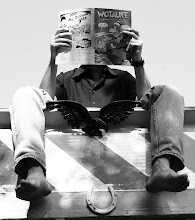
Where a man steps is indicative of where he is headed, and of what he is looking for.
But beyond every Hollywood Star there sits a banana peel, just waiting to dash a man’s hope for prosperity in this unforgiving world, turning Errol Flynn to Buster Keaton, Martha Graham to Lucille Ball.
We might walk a rope five hundred feet over a city – or we might walk the sobriety line, a flashlight beam between our spinning eyes – either way we are struggling to balance ourselves, death and pride hanging on the line.
Philippe Petit, the diminutive Frenchman who crossed the Twin Towers in 1974, was a man who would have been ignored on any busy intersection of New York City that overcast day, a slight figure cut like Jim Carroll playing Peter Pan.
But atop those monolithic bristles, scraping the mist-draped skies, he was a giant, the biggest man on Earth for one very famous afternoon, laughing at the police as he danced along a 2.5 cm cable, ignoring their demands to return to the rooftop upon which they huddled, dark blue birds watching a magical cat tread the heavens.
What is it that gives certain men such a flat view of the world, such indifference to perspective, that they can walk a rope strung across the hood of a circus tent, as if it were a chalk line on the sidewalk?
Is balance a relative thing? Is distance up to us?
Can we ignore the definition of space, compressing time so that our journey is over before it’s begun, a boat sailing the planet on the inertia of its own dreams, a child aging before our eyes, a prehistoric man searching his iPod?
If every ledge is but a curb to the bridge walker, is not every small step a leap for mankind, watching himself leaving the Earth, Neal Armstrong shitting into a plastic bag?
Men like Petit, Armstrong, Knievel, Earhart – stuntmen, daredevils, pilots and astronauts – they all chuckle in the face of fear, its mocking mask born of the quaking equilibrium, the lustful magnetic embrace of gravity, that which vertigo rules with its dizzying trickery.
It is commonly thought that those who suffer vertigines are afraid of heights, but this is simply not so. Acrophobia is the fear of heights, a position of predisposed fear, while vertigo is a physical malady which can cause one to literally fall to the floor, all sense of balance pulled from under suddenly untrustworthy feet – the carpet lining the lighthouse platform tumbling into the sea, Kim Novak slipping from Jimmy Stewart’s arms.
Calling a man burdened with vertigo afraid is like calling a chemically depressed individual sad. There are immeasurable depths of difference between the two, which only those inflicted can every truly know.
We learn to walk by putting one foot in front of the other, everyone a stop-motion penguin on ice, entrusting the surface of the planet to remain with us, even as it proceeds on its own accord, the turn of the axle-strung sphere leaving us in a momentary limbo, a weightless puppet hung to the air, a kite of skin and bone, our blood a stream of oxidized bubbles.
Just as the depressed force themselves through the floorboards, flattened to any sensation but the rapidly compressing shelves of their numbing malady, so do those who defy the orbital dictates, their focus unnatural, their concentration a laser beam burning a vault door – James Bond hurtling through the air.
When all is said and done, we must all heed gravity’s incessant conversation – the aerialist in her sequined tights, the drunken teenager blinking at twin moons, the seizure patient squeezing a rubber ball, the white-haired patriarch dropping into his pillow – all trapped as we are, in the back of destiny’s bus, time the ancient passenger mumbling into our chests, reminding us of life’s ruthless fall into decrepitude and disrepair – Philippe Petit grasping his walker, searching for his feet, not finding the ground.






